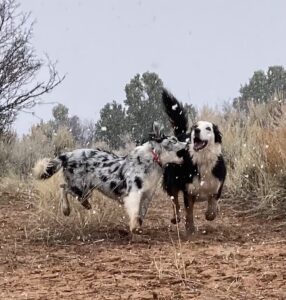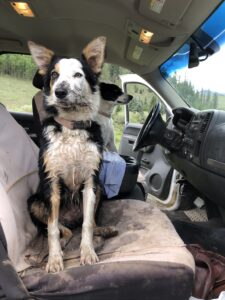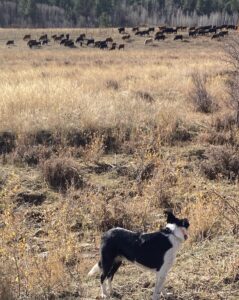Editor’s Note: This piece by Maddy Butcher was originally published in the Washington Post.
Here it is, but without the many links to research, statistics, and references. Sorry ’bout that!
By Maddy Butcher
Tina is smart and, sometimes, I’d swear she can read my mind. Monty is the sensitive one; when we make eye contact, he seems to ask, “What’s up?” and comes over for a consultation.
 They’re my dogs, part of the American canine population that is expected to top 100 million by 2030. Like a lot of people who live in remote settings, I spend more time with my dogs than with other human beings. And I freely admit to joining the national trend, observed by The Post a couple of years ago, of Americans noticeably increasing investing on pets.
They’re my dogs, part of the American canine population that is expected to top 100 million by 2030. Like a lot of people who live in remote settings, I spend more time with my dogs than with other human beings. And I freely admit to joining the national trend, observed by The Post a couple of years ago, of Americans noticeably increasing investing on pets.But, sorry, Dogue — Vogue magazine’s canine counterpart — this doesn’t mean I’m buying a Gucci carrier ($3,650) or a treat-tossing camera ($197). As for the $85 engraved “tag d’identité” — dog tag — from Pagerie, the self-described “ultra-luxury fashion house for pets,” the editors might deem it “essential,” but I don’t.
I might be a typical American when it comes to dog-ownership demographics, yet I find myself in the apparently shrinking minority of people who consider coddling and fancy accoutrements antithetical to good dog ownership. Worthwhile “investment” in a dog involves time and energy but not much money. Use dogs for what they were bred to do, if you can, and treat them like, well, dogs.
 Gregg Dubit also doesn’t buy much unnecessary stuff for his dogs or otherwise treat them like offspring. He tells me that of his two dozen or so Alaskan huskies, only one or two get to come in the house. Dubit runs the Durango Dog Ranch, a sled dog business, with his wife, Gretchen. He’s familiar with the concerns of animal-welfare groups such as People for the Ethical Treatment of Animals, which has targeted sled dog operations. As with any industry, unethical owners should be investigated, he says, but “the real battle” that PETA “should be fighting is for dogs that are locked in houses and apartments for hours alone.”
Gregg Dubit also doesn’t buy much unnecessary stuff for his dogs or otherwise treat them like offspring. He tells me that of his two dozen or so Alaskan huskies, only one or two get to come in the house. Dubit runs the Durango Dog Ranch, a sled dog business, with his wife, Gretchen. He’s familiar with the concerns of animal-welfare groups such as People for the Ethical Treatment of Animals, which has targeted sled dog operations. As with any industry, unethical owners should be investigated, he says, but “the real battle” that PETA “should be fighting is for dogs that are locked in houses and apartments for hours alone.”I concur. Towns, cities and nonprofit animal welfare organizations have done a good job of establishing dog shelters and supporting adoption. But how many dogs are saved from euthanasia, starvation, neglect, abuse or exposure only to die of boredom and obesity?
Cindi Hayden trains border collies on her 60-acre farm in New Hampshire. Dogs, she says, are communicating constantly with us. But a lot of us aren’t good listeners. “People don’t know the inside because they can’t read the outside,” she says.
Working border collies tend to pay attention to everything, all the time, says neuroscientist Erin Hecht, who runs the Canine Brains Project at Harvard University. She researches how selective breeding has created different behaviors and different brain organization. For instance, stock dogs, also known as working dogs, tend to have larger brain regions associated with drive, reward and vision.
 Like Hayden, Hecht worries that people can be unaware of what’s going on with their dogs. “We need to realize that situations that feel good for humans might not feel good to dogs. We should avoid making them into fluffy people,” Hecht says. On social media, she sees posts by dog owners of “smiling” dogs: mouths open, eyes wide. “They’re not smiling,” she says, “they’re stressed.”
Like Hayden, Hecht worries that people can be unaware of what’s going on with their dogs. “We need to realize that situations that feel good for humans might not feel good to dogs. We should avoid making them into fluffy people,” Hecht says. On social media, she sees posts by dog owners of “smiling” dogs: mouths open, eyes wide. “They’re not smiling,” she says, “they’re stressed.”Hecht’s colleague Sophie Barton says evolutionary biology can help explain the challenges for dogs in today’s culture. “There are often evolutionary mismatches between the purpose-driven traits their ancestors were bred for and the environment in which we expect them to live,” Barton says. “Dogs never evolved in an evolutionary environment where they were treated like people, specifically children, except for maybe now in recent years.”
Anthropomorphizing is fun, but it isn’t a good idea. Dogs like to smell stinky stuff (manure, dead animals), eat stinky stuff and roll in stinky stuff. Most would generally rather be outside than in. I’ve seen them reject pricey dog beds and seem perturbed by leather collars with brass monogramming, but never have I seen dogs turn down a walk or a play session.
 Tina and Monty usually log three to 10 miles a day. Sometimes, they go 20 miles or more. They work cows in the San Juan National Forest and on gravel roads and dryland pasture. They seem to get really excited — wagging tails, yipping, circling, keenly paying attention — when I hook up the horse trailer. Loading horses usually means moving cows. Alternatively, they seem bothered and restless on our down days. Part of the reason I run is to bring them along and satisfy their need for activity.
Tina and Monty usually log three to 10 miles a day. Sometimes, they go 20 miles or more. They work cows in the San Juan National Forest and on gravel roads and dryland pasture. They seem to get really excited — wagging tails, yipping, circling, keenly paying attention — when I hook up the horse trailer. Loading horses usually means moving cows. Alternatively, they seem bothered and restless on our down days. Part of the reason I run is to bring them along and satisfy their need for activity.As Barton mentioned, most breeding has been purpose-driven, and I believe dogs tend to be healthier and happier when their lives have a point. Pretend jobs are fine! Agility, obedience, and fetch sessions can nurture partnership, discipline, confidence and stress release. It can be harder in cities to make time and find room for those pretend jobs, but plenty of dog owners make it happen.
Here in Montezuma County, stock dogs like mine make up about half of the canine population. Stephanie Stuckman, an assistant at Mancos Valley Veterinary Hospital, tells me that they are purebreds or mixes of heelers (also known as Australian Cattle Dogs), Aussies (Australian Shepherds) and border collies. Only a fraction of them work livestock, she says, but most are active, owned by people who walk, hike and bike with them.
Still, even here, canine obesity and antisocial behavior can be problematic. Clients sometimes call the clinic, Stuckman says, asking for drugs or something they can buy to calm down dogs that are left alone in a house and chronically agitated. Stuckman says she tries to remind the owners that what their dogs really need is to walk and run. To smell stinky stuff. And then to walk and run some more.
Love this!!!
I reamed a customer service rep at Chewy who asked, “How can I help you with your babies?” 🤮🤮🤮 It really touched a button.
Glad you could give them helpful feedback, Kerry. :))
Great essay, Maddy. As true in Maine as it is out west.
Thanks, Sue. Great to hear from you.